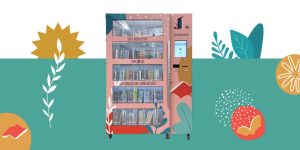Taking it to the Streets: New Models
Wendy MacNaughton, artist and illustrative journalist, says that “drawing is looking, and looking is loving.” This is what first came to mind when taking a look at Anythink Library’s Get to Know Your Neighbor program, where a bench and ice-breaker type questions were provided, with the aim of getting to know the neighbors and community members better. MacNaughton’s program functions in a similar way, though instead of asking questions, strangers are invited to sit down and draw each other without looking at their paper. She even took this program to the National Gallery of Art.
The point, of course, of both of these exercises is learning to see–really see each other, and to slow down and engage with someone that is no longer a complete stranger. Libraries, of course, are all about visibility and community, and having a library be the nexus of these kinds of programs is a natural outcropping of what the library is and can be. This kind of engagement, of course, is also an actionable antidote to fear mongering and siloing ourselves in our own bubbles–if everyone you see is a stranger, then the world is strange and scary; if the world is full of friends you haven’t met yet, the world is warm and welcoming, and it’s easier to treat others with dignity and respect–and to establish empathy with one another.
The Library is perfectly poised to provide space and programming to meet the dignity of all of us, from providing nutritional education (Ewen, 2018) to offering library cards to people without a fixed address (Rees, 2018). Thinking beyond the square footage of a building and the idea of a permanent collection can help library users to stretch their own ideas about their communities– “People, not books” (Stephens, n.d.). The commitment to service and seeing us all remains, regardless of the method or medium.
Though of course there will always be books, and there should be (Lefrink, 2018)! On that point, I ran across this the other day and am excited to share it–from the San Francisco public library. Vending library kiosks have been placed in certain neighborhoods, and all you have to do to get a card is live in the neighborhood. Taking the library out from a fixed spot and providing access via micro stations is exactly what the Library and the idea of community presence is all about.

References
Ewen, L. (2018, September 4). A moveable feast: Libraries use mobile kitchens to teach food literacy. American Libraries. https://americanlibrariesmagazine.org/2018/09/04/movable-feast-library-mobile-kitchens/
Lefrink, S. (2018, January 24). To keep people happy… Keep some books. Next. https://blog.oclc.org/next/to-keep-people-happy-keep-some-books/
National Gallery of Art. (2024, July 31). What happens if two complete strangers draw each other [Video]? YouTube. https://www.youtube.com/watch?v=q2otlX_c80M
Rees, M. (2018, December 3). No permanent address? No problem. Berkeley library makes it easier for those without homes to get library cards. Berkeleyside. https://www.berkeleyside.org/2018/12/03/no-permanent-address-no-problem-berkeley-library-makes-it-easier-for-those-without-homes-to-get-library-cards
Stephens, M. (n.d.). The hyperlinked library: Participatory service & transparency [Webinar]. San José State University. https://sjsu-ischool.hosted.panopto.com/Panopto/Pages/Viewer.aspx?id=2a19a4b6-e945-4d2e-abf1-aef3014172a5
6 Comments
Ali Ongaro
Hi Mei, I have never seen a library book vending machine before, so cool! I enjoyed your note on “learning to see–really see each other, and to slow down and engage with someone that is no longer a complete stranger. Bringing this up is so relevant, it seems like most people blast through life and don’t stop to smell the roses or notice others. I think there also was a social shift the pandemic, people may not be as social with strangers as they used to be because we were isolated for a couple years. You bring up some great points in your post, thanks for sharing 🙂
Mei C.
Hey @ali0! I completely agree that the pandemic stunted our social skills, and I think the always on always available mentality that grew in force during that time. The attention economy rewards moving quickly without stopping to appreciate what we have and where we are, and I think also the increasing polarization of our society indicates that there is a lot of non-seeing. As much as I appreciate and am grateful for the technologies that allowed us to remain connected during that time, I also think that they’ve taken over in primacy, and that developing real-time face-to-face responsive skills has taken a huge hit. Hopefully we can change that and move back to putting people first!
Thanks for stopping by!
Daisy Chia
Hi @meic
I love Wendy MacNaughton! I love DrawTogether Strangers! We started following her during the pandemic and I really want to run this one day at a library! She has all the instructions available online.
You brought together a great pile of ways that libraries can help break through the bubbles and help us connect with each other; the library as the empathy machine. Nice post.
@daisychia
Mei C.
@daisychia Please keep me posted if you host this kind of program! I would really be interested in how it turned and your thoughts on it! Thanks for reading!
Becky Steenburg
Hi, Thanks for sharing that video, what a wonderful idea! I also loved Anythink’s “get to know your neighbor” couch sessions. Both ideas are so wonderful. The McNaughton quote is equally fantastic. I loved this whole piece, great work! Thank you for sharing.
Michael Stephens
@meic I love the example of stangers drawing each other. What a neat twist on an icebreaker or get to know you type activity. Yay for kiosks too – the library can be everywhere!